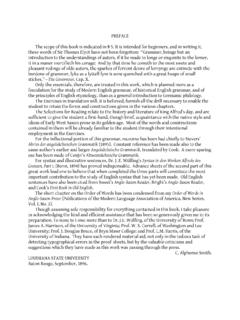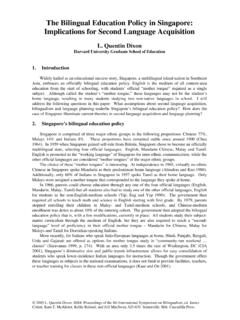Transcription of Comparative and Historical Linguistics
1 UNESCO EOLSSSAMPLE CHAPTERSLINGUISTIC ANTHROPOLOGY Comparative and Historical Linguistics - Ranko Matasovi Encyclopedia of Life Support Systems (EOLSS) Comparative AND Historical Linguistics Ranko Matasovi Department of Linguistics , University of Zagreb, Croatia Keywords: Genetic Linguistics , language typology, areal Linguistics , language families, proto-language, language change, sound law, lexical diffusion, isogloss, implicational universal. Contents 1. Introduction 2. Historical Overview The Early History The Nineteenth Century The Twentieth Century 3. Genetic Linguistics Principles of Language Change Models of Genetic Relatedness Proofs of Genetic Relatedness The Major Language Families of theWorld 4. Typological and Areal Linguistics Typological Classification Areal Classification Glossary Bibliography Biographical Sketch Summary This chapter begins with a brief survey of the Comparative research into language diversity and development.
2 Historical Linguistics is presented as the scientific study of language change. Language change affects all levels of language structure, and it eventually leads to language split, or creation of languages-descendants from common proto-languages. The discovery of common proto-languages is the main object of genetic Comparative Linguistics , which classifies languages into language families. Several models of genetic relatedness of languages are discussed, as well as the methods of proof of genetic relatedness. A brief genetic classification of major language families of the world is included. Typological study of language is concerned with assessing the structural features according to which languages may differ. Languages sharing several logically independent features constitute a language type. Finally, areal Comparative Linguistics classifies languages into language areas, sets of languages that influenced each other during periods of intensive language contact.
3 Several language areas of the world are enumerated and briefly discussed. UNESCO EOLSSSAMPLE CHAPTERSLINGUISTIC ANTHROPOLOGY Comparative and Historical Linguistics - Ranko Matasovi Encyclopedia of Life Support Systems (EOLSS) 1. Introduction Comparative and Historical Linguistics are often treated as a single discipline, although they actually differ considerably with respect to their goals and methods. Comparative Linguistics is the scientific study of language from a Comparative point of view, which means that it is involved in comparing and classifying languages. To compare languages is to discover the features they share, while the classification of languages proceeds by discovering the relevant defining principles for various classes of languages. Languages can be compared and classified according to three different principles: genetic, typological, and areal.
4 The basic unit of genetic classification is the language family, the set of languages for which it can be proved that they developed from a single ancestor, called the proto-language of that family. The notion of proof of genetic relatedness is crucial here, because all human languages might, or might not be ultimately derived from a single proto-language. The basic unit of areal classification is the language area (the German term Sprachbund is also sometimes used). It denotes the set of languages for which it can be shown that they developed a number of features as a consequence of mutual contacts. Finally, the basic unit of typological classification is the language type, which refers to the set of languages that share some typologically relevant set of features. What "typologically relevant" means here will be explained below. Historical Linguistics is the Historical study of language change and development.
5 Its results are directly relevant to Comparative Linguistics , because only by taking into account the history of languages can we understand why some of them share some of the features they do. This can be for one of the three following reasons: 1) because they stem from some common source, in which case we speak about genetic relatedness of languages; 2) because they influenced each other during periods of intensive language contact, in which case we speak of areal affiliation of languages, and 3) because their failure to share the features in question would violate some basic and non-obvious principles determining the structure of a possible human language; in that case we claim that languages are typologically related, or that they belong to the same linguistic type. In what follows, we shall consider all three of these instances of linguistic relatedness, and examine the methods for discovering them.
6 2. Historical Overview The Early History Although they made some interesting contrastive remarks about the grammars of Greek and Latin, classical grammarians did not show any interest in comparing languages systematically. The chief reason for this was the fact that for Greeks and Romans the study of language was not a theoretical discipline, concerned with explanations, but rather a practical one, whose primary task was to provide grammatical descriptions of the written language used by culturally important authors. Therefore, the study of barbarians' languages was not considered as a worthwhile objective. It was not until the interest in European vernaculars was aroused during the late middle ages that Comparative approaches to language really took off. Dante Alighieri (1265-1321) was the first to attempt a classification of European languages of his time.
7 In his work De vulgari eloquentia ("On the Vernacular Speech") he clearly distinguished between UNESCO EOLSSSAMPLE CHAPTERSLINGUISTIC ANTHROPOLOGY Comparative and Historical Linguistics - Ranko Matasovi Encyclopedia of Life Support Systems (EOLSS) Greek, on the one hand, and the Slavic, Germanic, and Romance languages, on the other; he was also fully aware of the fact that languages diverge over time and that dialectal differences arise because different changes occur in various areas in which a single language is spoken. While Dante used the words for "yes" in order to classify the European languages, Giuseppe Scaligero (1540-1609) used the word for "God", thereby classifying the languages of Europe into "deus-languages" (Latin and the Romance languages) "gott-languages" (the Germanic group), "boge-languages" (the Slavic group), and Greek, in which the word for "god" is theos.
8 However, he thought that there was no relationship between these groups of languages, which he called "matrices". On the other hand, Gottfried Wilhelm Leibniz (1646-1716) came very close to recognizing the fundamental relatedness of (Indo-European) languages of Europe, most of which he classified as "Celto-Schytian". During the Renaissance period and in the 17th and early 18th century, many scholars speculated about the "original language of humankind". Besides Hebrew, which was perhaps the obvious choice, several candidates for that status were advanced, including Chinese (by Webb, in 1669) and Dutch (by Goropius, in 1569). The positive impact of these speculations was that scholars became aware of the scale of language diversity and the ubiquity of linguistic change. The trend toward the accumulation of data about the languages of the world was enhanced by publications of grammars and dictionaries of many languages during the Reformation and Counter-Reformation periods.
9 For example, the first grammar of Basque was published in 1587, the first Polish grammar in 1586, and the first grammars of the American Indian languages Nahuatl, Quechua, and Guaran were published in 1547, 1560, and 1595, respectively. The encyclopedic movement in the 18th century also contributed to the availability of data about non-European languages. Basic data about several hundred of the world's languages were compiled in Johann Christoph Adelung's (1732-1806) compendium Mithridates. In the eighteenth century information about Sanskrit, the learned language of India, became known among the learned circles in Europe. This was mostly due to the work of Christian missionaries in India, such as the French Pierre de Coeurdoux, or the Croat-Austrian Filip Vezdin (a. k. a. Paulinus a Sancto Bartholomaeo, 1748-1806), who published the first European grammar of Sanskrit.
10 While many scholars had thought that the similarities of major European languages could be explained as the result of language contact, the obvious similarities of basic Sanskrit words with their synonyms in the classical languages required a different explanation. It was highly unlikely that the similarity between, e. g., Sanskrit pitar- "father", m tar- "mother", and bhr tar- "brother" with Latin pater, mater, and frater could have been the result of borrowing. It was not long before William Jones (1746-1794) proposed that Sanskrit, Greek, Latin, and several other languages we now call Indo-European, had "sprung from some common source, which, perhaps, no longer exists." In his programmatic lecture before the Asiatic Society in Calcutta in 1786, which became widely known in Europe, he also emphasized that the similarities between Sanskrit and the classical languages were not limited to the similar shapes of words, but also extended to grammar.















